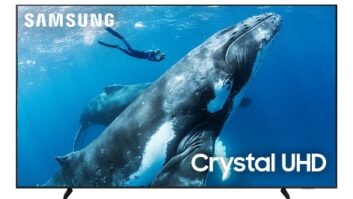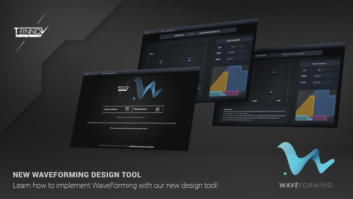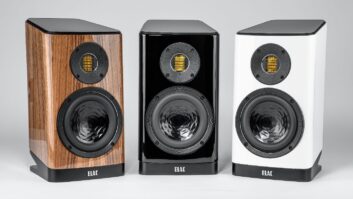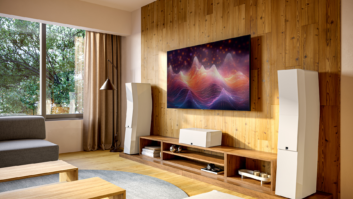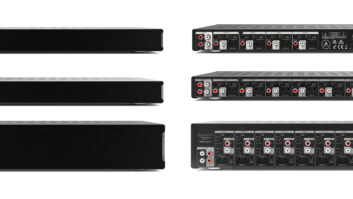So youre itching to know what the new technology design trend will be? Well forget about silver. Nano is the new black.
Celebrating the defiantly small, nanotechnology proved to be a dominant aesthetic theme at CEDIA EXPO 2004 in Indianapolis last month. Nanotechnology literally refers to the engineering of nanometers (those unimaginably small metric units equal to one billionth of a meter), but it is the futuristic symbolism that has made downsizing cool. Its still a young science, but the art of manipulating microscopic material is the focus of research facilities around the world. I believe nanotechnology will profoundly affect manufacturing, information technology, healthcare, the arts and design by making products more precise.
Even fickle fashionistas agree: slim is in. In 2005, everything from mobile phones to iPod minis, high-end projectors to LCD screens and even the MINI Cooper will capitalize on petit profiles. There are even rumors of a new
iMac in production that’s actually smaller than a breadbox.
But small is only one side of the style story. The big news is that while hardware is shrinking, features and memory capacity are growing. At EXPO, the worlds premier custom electronic technology showcase, companies such as Pelham Sloane, Sharp and Proficient offered smaller and more efficient products that could be tucked away when not in use, or installed off-axis and out of site. Despite the occasional stately monolith and super-sized HD display, this year the most buzz surrounded the space-conscious chassis.
Polk Audio and Netstreams showed off stealthy in-wall speakers that feature robust IP functionality. You might miss them recessed in the wall, a fact that makes their performance even more impressive.
With its protean Bravo server, Meda Systems packed a 20-zone digital music punch into one box that would have required a tower of components five years ago. Parasound unveiled the v.3 upgrade to its compact Zamp zone amplifier for use in custom installations and audio systems. At $300, the v.3 is a stereo power amplifier capable of 45 watts per channel into an 8-ohm load, 150 percent more powerful (and cooler) than its predecessor. Class D and T amplification, lauded for its compact size, is finally starting to sound as good as it looks, and custom integrators are elated. NuVo Technologies, ELAN and other luminaries also made blockbuster digital amp introductions.
RESI Award finalists such as coNEXTion and Russound showed ingenuity by creating great products that performed stunningly and conserved real estate. Artisons design coup was the Portrait LCR Speakera flush-mountable sonic solution that enhances, rather than corrupts, plasmas chic aesthetic code.
In its RESI-winning DVR-50, Jamo incorporates DiVx and universal DVD playback within a standard-size device that echoes the convex design of its sister components. ADAs HTR-2400, which captured an A/V controller/receiver RESI nomination, integrates into one unit an amplified eight-source multi-room A/V system full-digital 7.1 amplification, and its anchored by a seven-inch 16×9 LCD preview display. Crestrons 10-inch WiFi touchpanel and a Lilliputian four-inch wallpanel from ELAN underscore the demand for diminutive. SIM2s HTL40 LINK, a slender new 40-inch LCD, has the depth of a Frisbee; this gorgeous product is just few inches deep and offers advanced video processing.
Media servers further prove that products need not resemble a mini-fridge to hold colossal memory. Kaleidescape, AMX MAX, ReQuest and Xperient have slammed mammoth storage into smart designs. Interact-TVs new product, the Telly MC1200, is a slim server that can store and manage video, DVD and music libraries, burn CDs, pause and record live TV and store and display digital photos on the living room TV.
As consumer appetites increase, the terabyte will soon be the new gig in town. Most media servers currently offer terabytic storage (one terabyte equals one thousand gigabytesenough room for 1,000 DVDs and 100,000 songs). And I guarantee that gear-heads are already sniffing up the petabyte (PB), a data unit of over 1,000 terabytes (a quadrillion bytes). As a recent BBC report ascertained, a 32PB media player would store seven billion MP3s or 50 million movies. The yottabyte and brontobyte media players wouldnt be too far behind. A brontobyte is million-million petabytes, offering infinite storage space for every form of media thats ever been recorded, photographed, spoken, written or conceived. If thats the future of standard storage and hardware continues shedding weight, I think next years hot technology design trend might just be the hologram.
Margot Douaihy is managing editor of Residential Systems in New York City.


